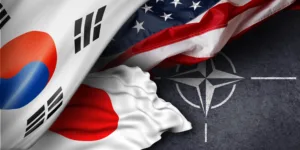Myanmar faces a dual crisis of civil war and climate-related disasters, underscoring the urgent need for both governance reform and climate action to prevent further regional destabilization in Southeast Asia.
Key takeaways:
-
Myanmar’s civil war and frequent climate disasters have combined to create a severe humanitarian crisis, deepening the country’s fragility and leading to widespread displacement.
-
ASEAN’s Five-Point Consensus has seen limited progress, revealing challenges in the bloc’s ability to manage complex member-state conflicts and raising concerns about its effectiveness as a regional peace mediator.
-
The strategic ties that China, India, and Russia maintain with Myanmar’s military junta complicate peace efforts, underscoring the need for global actors to work with opposition groups and bypass military restrictions to ensure aid delivery and foster Myanmar’s stability and sustainability.
Myanmar is at the epicenter of two intersecting crises—a civil war and climate-related disasters—deepening its position as one of the world’s most fragile states. Ranked 12th in the 2023 Fragile States Index, it is also the most fragile nation within ASEAN. These twin crises highlight broader issues of governance failure, regional instability, and the global challenge of addressing the vulnerabilities of fragile states in the context of a rapidly changing climate.
Since the military coup in 2021, Myanmar has been engulfed in an intense civil war, with the State Administration Council (SAC), the formal name of the military junta, battling the democratically elected National Unity Government (NUG), its People’s Defense Forces (PDF), and various Ethnic Armed Organizations (EAOs). The result has been the country’s fragmentation into multiple conflict zones, with no central authority able to restore stability. The mass exodus of Burmese youth to ethnic armed group territories and the migration of professionals to neighboring countries underscore the deepening uncertainty and instability. Protests in Thailand against Myanmar migrants and growing anti-immigrant sentiment in Malaysia indicate that Myanmar’s crisis is no longer a domestic issue but a threat to ASEAN’s sustainability and stability.
International responses, particularly within Southeast Asia, have been mixed. In 2021, ASEAN proposed the Five-Point Consensus (5PC), calling for ending violence and inclusive dialogue in Myanmar. However, the lack of tangible progress has led to frustration within the bloc. Myanmar’s political representatives have been banned from regional summits, signaling ASEAN’s disapproval of the SAC’s intransigence. The recent call by ASEAN foreign ministers to review the 5PC ahead of the annual ASEAN Summit in October reflects the growing recognition that the current approach has failed. Meanwhile, China has recalibrated its stance on Myanmar, influenced by the recent regime change in Bangladesh, pushing ASEAN Chair Laos to foster stronger ties with Myanmar’s military regime— evident in the invitation for a representative of the military-controlled Foreign Affairs to the ASEAN summit for the first time since 2021. Conversely, Indonesia remains committed to fostering dialogue by supporting resistance groups, highlighting ASEAN’s varied approaches to Myanmar’s political crisis.
The broader geopolitical context further complicates the situation. While ASEAN has struggled to mediate, neighboring countries like China, India, Thailand, and international actors such as Russia continue to engage with the SAC for strategic and economic reasons. China, in particular, wields significant influence due to its economic ties with Myanmar’s military. Recent diplomatic visits by Chinese Foreign Minister Wang Yi demonstrate China’s cautious support for ASEAN’s peace efforts, though Beijing continues to work directly with the junta. However, China’s ability to push the SAC towards negotiations remains uncertain, especially as the junta tightens its grip on power by designating ethnic groups as “terrorist organizations” and escalating military recruitment under the conscription law.
Climate change and the humanitarian crisis
Myanmar’s political conflict is compounded by its extreme vulnerability to climate-related disasters. The country frequently experiences floods, droughts, cyclones, and other natural hazards, all exacerbated by poor infrastructure and inadequate disaster preparedness. Recent catastrophic flooding caused by Typhoon Yagi, which claimed over 300 lives and displaced thousands, illustrates the severity of Myanmar’s environmental challenges.
Civilians in areas controlled by both the SAC, PDF, and EAOs suffer alike from these disasters, highlighting the deterioration of Myanmar’s resilience to climate shocks. On the other hand, rescue operations in Myanmar are significantly hindered by the prevailing political instability and clashes between the Myanmar military and revolutionary forces. Aid organizations face restrictions to access, especially in flood-affected areas like Shan State, due to the military junta’s blockade on transporting essential supplies such as rice and medicine to regions under revolutionary forces’ control. At the same time, many people, including the middle class, continue to grapple with inflation and rising commodity prices, further weakening their financial stability.
The convergence of conflict and climate disasters has resulted in a profound humanitarian crisis. The United Nations Office for the Coordination of Humanitarian Affairs (UNOCHA) estimates that by the end of 2023, more than 2.6 million people will be internally displaced, and nearly 19 million—about one-third of the population—will require urgent assistance in areas such as food, healthcare, and education. International humanitarian efforts have struggled to meet these growing needs, with many aid agencies scaling back or redirecting resources due to the political situation.
Myanmar’s declining climate resilience points to a larger issue: fragile states already overwhelmed by internal conflict are ill-prepared to cope with the escalating impacts of climate change. Without coordinated international intervention that addresses both governance and environmental challenges, Myanmar’s fragility will continue to worsen, with serious repercussions for the region.
Strategic implications for ASEAN and international actors
Myanmar’s crisis has significant implications for regional stability. The civil war and resulting humanitarian disasters threaten to destabilize neighboring countries, particularly Thailand, which has taken in large numbers of refugees, and China, which has key economic interests tied to Myanmar’s stability. ASEAN’s credibility as a mediator is also at risk. If the bloc cannot find a way to revive the stalled peace process, its relevance in resolving intra-regional conflicts could be called into question.
The international community has been hesitant to intervene directly in Myanmar, preferring to support ASEAN’s efforts. However, as the conflict drags on, there is a growing realization that ASEAN’s 5PC may require significant revision. ASEAN may need to engage more directly with opposition forces such as the NUG and EAOs to foster a more inclusive dialogue that reflects the realities on the ground.
Meanwhile, international actors like the United States, the EU, Australia, and humanitarian organizations must ensure that aid reaches civilians regardless of which faction controls the territory. Cross-border operations coordinated with the NUG and EAOs could bypass restrictions imposed by the SAC, delivering vital humanitarian assistance to conflict-affected areas.
The intersection of political fragility and climate vulnerability in Myanmar is emblematic of a broader global trend. Fragile states, weakened by internal conflict and poor governance, are disproportionately affected by climate change. Myanmar’s situation demonstrates how conflict and environmental degradation can reinforce each other, creating a vicious cycle that erodes state capacity and deepens human suffering.
Addressing Myanmar’s climate vulnerabilities is impossible without resolving its political conflict. Governance lies at the heart of this crisis. Without a functional government capable of coordinating disaster response and rebuilding the country’s resilience to climate change, Myanmar will continue to slide deeper into fragility.
Myanmar’s future remains uncertain, but one thing is clear: the international community cannot afford to ignore its crisis. ASEAN’s leadership is crucial, but it must evolve. A more robust, inclusive approach is needed to incorporate direct engagement with the NUG and EAOs. At the same time, key regional players like China, India, and Thailand must prioritize long-term stability over short-term strategic interests by supporting a negotiated settlement that paves the way for a democratic transition.
Myanmar’s crisis is a test of international diplomacy, governance, and climate resilience. In her new role as Special Envoy of the United Nations Secretary-General on Myanmar, former Australian Foreign Minister Julie Bishop must intensify diplomatic efforts, working alongside ASEAN to address the situation. The global community must act swiftly to prevent further deterioration, as the consequences of inaction could extend well beyond Myanmar’s borders, turning this into a complex regional crisis.







